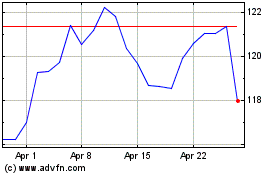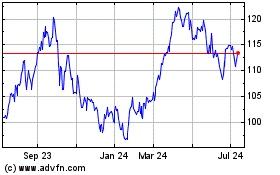BP Faces Down Its Doubters
February 04 2018 - 9:29AM
Dow Jones News
By Sarah Kent
LONDON-- BP PLC is struggling to convince investors it can
regain its top position among the world's elite energy players
nearly eight years after the Deepwater Horizon disaster.
Chief Executive Bob Dudley has staked his legacy on reversing
the company's lost prestige and turning it from a survivor into a
stronger, more profitable company than it was before the 2010 oil
spill. Since the disaster in the Gulf of Mexico, the company has
tumbled from being the biggest oil and gas producer among Western
publicly listed companies to third, behind Exxon Mobil Corp. and
Royal Dutch Shell PLC.
Since BP outlined what it calls its "Getting Back to Growth"
strategy last February, its executives say they have been met with
skepticism from investors that have become disillusioned with a
sector that has historically over-promised and under-delivered.
The company still has the weakest growth prospects among the
world's big oil companies, says Macquarie, the Australian
investment bank.
"I think it's right the shareholders are waiting to see delivery
before they start getting behind the strategy," BP Chief Financial
Officer Brian Gilvary said. He added that the company wouldn't have
released its strategy "if we did not think we could deliver
it."
BP's fourth-quarter results, due to be released on Tuesday, are
an important milestone in the company's efforts to prove its
doubters wrong. The company is expected to report net profit of
$5.4 billion for 2017, its highest earnings since before oil prices
crashed nearly four years ago, according to consensus estimates
compiled by S&P Global Market Intelligence.
It comes after mixed results for competitors. Shell's net profit
tripled last year, though investors are worried about a drop off in
cash flow. Earnings at U.S. rivals Exxon and Chevron Corp. fell
short of expectations and were punished with a substantial selloff
on Friday.
Though BP's share price managed to reach its highest level in
eight years last month on the back of an oil-market rally, it has
underperformed compared with its British-Dutch rival Shell. The
British oil giant's stock still trades roughly 20% bellow the price
it commanded before the 2010 Gulf of Mexico blowout--a reminder of
how far the company still has to go as it seeks to regain its
former heft.
"With BP, investors tend to still be a little bit skeptical that
they're going to do what they say they'll do," said Brian
Youngberg, an analyst with Edward Jones in St. Louis.
Those concerns were underlined last month when BP disclosed it
would take a new, unexpected $1.7 billion charge related to
settlement costs from the disaster. That added to the company's
nearly $65 billion bill stemming from the worst offshore oil spill
in American history and reminded shareholders of the company's
Deepwater Horizon handicaps.
BP has outlined a path to return its oil and gas production to 4
million barrels a day, helped by 800,000 barrels a day of new
production by the end of the decade. It told shareholders it plans
to boost its free cash flow to as high as $24 billion by 2021.
"Investors looked at that and said, 'Nah!,'" Mr. Gilvary said in
a recent interview.
Mr. Dudley calls Deepwater Horizon costs amounting to over $1
billion a year a "headwind" no other company faces. But higher
earnings--if they materialize for BP--would come after some success
in delivering on its strategy over the past year.
It started up a record seven new projects in 2017 and, in a sign
of growing financial strength, announced plans to recommence share
buybacks in October. The company is expected to use its
fourth-quarter results to underscore its confidence in the strategy
that was laid out last February and paint an optimistic picture of
its longer-term prospects beyond 2021.
"We just have to keep delivering," Mr. Dudley said in an
interview. The company is "back on its feet. It's beyond walking,
now it's starting to run."
"I think it's slightly unfair that people still don't believe
them," said Rohan Murphy, an energy analyst at Allianz Global
investors, which holds BP stocks. "They are doing it and proving it
in their quarterly numbers."
Write to Sarah Kent at sarah.kent@wsj.com
(END) Dow Jones Newswires
February 04, 2018 09:14 ET (14:14 GMT)
Copyright (c) 2018 Dow Jones & Company, Inc.
Exxon Mobil (NYSE:XOM)
Historical Stock Chart
From Mar 2024 to Apr 2024

Exxon Mobil (NYSE:XOM)
Historical Stock Chart
From Apr 2023 to Apr 2024
